In February and March, as the fruits of Israel's flash immunization program began ripening, things finally appeared to be changing. By mid-April, the pandemic effectively over, roughly half a dozen countries became genuinely realistic destinations for vaccinated Israelis. They could fly out sans the need for a PCR test, i.e. without the risk of a positive test result prior to departure blowing a hole in their plans, and without the need to quarantine upon arrival at their destination. These countries were Albania, Croatia, Cyprus, Georgia, Greece, Montenegro, and Seychelles. With a twelve-day, April 23rd to May 4th spring break approaching, I cracked my knuckles and got to work trawling the internet for flights.
 |
| מונטנגרו נדבקים חדשים טבלה יומית Montenegro SARS-CoV-2 new daily infections |
Could Montenegro be a perfect spring getaway? There were reasons to suppose that it could and reasons not to get too hopeful. Pro: Israir Airlines was offering direct round-trip flights to Montenegro's Tivat Airport for $240. Con: For some reason, a ticket from April 23rd to May 3rd bounced the price up 42% to $340. Pro: Montenegro had a steeply declining SARS-CoV-2 daily new cases graph. Con: News reports indicated numerous restrictions were in effect on travel inside the country, including weekend travel between cities and all travel in and out of the capital. Pro: Theculturetrip.com called Montenegro's Adriatic beaches "sun-drenched." Con: The weather forecast called for rain on six of the first seven days of the trip. The bottom line was there were too many variables at play to reliably determine at what level to set expectations.
 |
| נמל תעופה בן־גוריון אל נמל תעופה טיווט Ben-Gurion Airport to Tivat Airport Source: Google Maps |
- Tivat post office
Drops of rain were streaking across the windows as the plane descended toward Tivat. There goes my plan to walk from the airport to my accommodations for the first night, I thought to myself. After the pilot set us down, to a round of applause for his soft landing, I observed as the ground crew was carefully security-scanned before being allowed to approach our craft. It was disappointing to see they all had masks on. Had I come all this way only to be denied a view of Montenegrin women? A light rain greeted us as we stepped outside the plane and walked to the airport building, followed by the pungent stench of cigarette smoke as we entered the building and proceeded to border control.
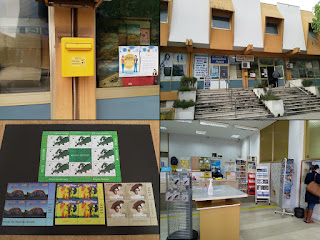 |
| דואר מונטנגרו: סניף טיווט צילום: אמיר אפסאי Pošta Crne Gore: Tivat post office Photos: Amir Afsai |
Having meanwhile also arranged alternate accommodations in the village of Mrčevac, at 14:00 the rain finally let up and I left my apartment to scout out the neighboring town of Tivat. Specifically, I sought to determine if Tivat was a venue worth returning to later for a run. Situated on a shore of the Bay of Kotor, which links to the Adriatic Sea, Tivat's chief attraction is its waterfront, including the upscale, Dubai-owned Porto Montenegro. My most memorable experience, however, was a visit to Tivat's post office. There was a small line outside the entrance since, on account of the pandemic, only those being served and next in line were allowed inside. Four stations were occupied by clerks: three general-purpose stations and one packages station. Two of the three general-purpose stations were closed; but when I approached one and asked if I could buy postage stamps and mail a postcard, the woman behind the glass immediately sprang into action and offered her services. I bought €13.80-worth of Montenegrin stamps and sent a postcard to Tel Aviv whose stamp was expertly and cheerfully hand-canceled on the spot.
Day 2, Saturday:
- Budva post office
- Citadela Budva
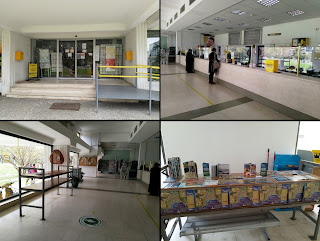 |
| סניף דואר בודווה אמיר אפסאי Budva post office Photos: Amir Afsai |
Saturday was April 24th, Armenian Genocide Memorial Day. Although not Armenian myself and although Israel does not consider the attrocities perpetrated against Armenians during World War I a genocide, my work with the Armenian community in Israel and a six-week visit to Armenia in 2018 have engendered a connection to the Armenian nation that transcends ethnic and political lines. Had I been in Jerusalem, I would be attending the Armenians' memorial gatherings there and participating in their annual march to the Turkish Consulate. What was the chance Montenegro had an Armenian community and that there would be a ceremony in the country I could attend? An article at Armenpress.am indicated that Montenegro was home to a tiny Armenian population, that they had a church "near Budva," and that on 24 April 2017 they had held a memorial ceremony at the church. That would have been my next stop for the day, except I was never able to track down the church's location, nor anyone who knew of it.
 |
| השער הראשי (שמאלי עליון), מבצר בודווה, גלויה צילום: אמיר אפסאי Velja Vrata (top left), Citadela, postcard Photos: Amir Afsai |
Entering the Old Town through the wall's main gate, Velja Vrata, to the right of which a yellow mailbox was mounted to the wall, I did my best to follow Google Maps' directions to a bar whose reviews mentioned craft beer. The narrow alleyways kept zigzagging and dead-ending and leading me astray, but in the end all the bar had on offer were two uninteresting bottled beers and no food. Some more aimless meandering and following cats led me to the first of three museums I would visit on the trip: Budva Citadel Museum. The €3.50 entrance fee rewarded me with access to a gallery of model ships, to a handsome library, and to a rampart with views out to the sea and over the roofs of the town, as well as with a numbered postcard (№ 0011762) that doubled as an admission ticket. The front of the postcard is a collage of five images in and around the museum; the back features a floor plan of the museum's three levels. Given the postcard's perforated edge, I reckon it to be part of a set.
Day 3, Sunday:
- Boreti post office
- Pržno post office
- Budva Old Town post office
 |
| סניפי דואר של בורטי (שמאלי עליון), פרז'נו סבטי סטפן, סניף דואר בודווה העתיקה Boreti (top left) and Pržno post offices Sveti Stefan, Budva Old Town post office |
The run to Sveti Stefan took me past two post offices. Both, like the supermarkets, were closed for Sunday. The first was in the village of Boreti. It was small and looked run-down but was centrally located at an intersection on the E80 coastal highway. The second was on a side street in the village of Pržno -- slightly larger than Boreti's post office but in similar condition, at least from the outside, and situated at the rear of a small shopping center elevated above street level. Beyond the shopping center was an archway leading into a wooded park that it was sad to see being eaten into by a luxury residential development. Two picturesque cove beaches -- Queen's and Milocer -- followed, and I emerged from the park at a footbridge connecting the mainland to the islet of Sveti Stefan. The view toward Sveti did not disappoint: it was postcard-level stunning. What did disappoint was that accessing Sveti was only possible as part of an organized tour, and the only tour visiting the island that day was fully booked. Rather than run back to Budva, I lingered long enough for the image of the island to get burned into memory, then hiked back, stopping at a park gym to do some pull-ups. Returning to Budva's Old Town in search of lunch, I happened upon a small post office that had eluded my radar on Saturday.
Day 4, Monday:
- Podgorica main post office
- Bulevar Svetog Petra Cetinjskog post office
 |
| פלנטאז צילום: אמיר אפסאי Plantaže Photos: Amir Afsai |
In 2005, the theme of PostEurop's EUROPA stamps competition was gastronomy. 2005 was also the first year the modern republic of Montenegro issued stamps. Apparently there was some confusion on the part of Pošta Crne Gore, i.e. Montenegro Post, or else its stamps weren't yet recognized as internationally valid: it issued four stamps bearing the EUROPA logo and none of them is listed at PostEurop's archive page for EUROPA 2005 stamps. Nevertheless, the fact that one of Pošta Crne Gore's 2005 EUROPA stamps was devoted to grapes and wine demonstrates the centrality of viticulture to Montenegro's gastronomic heritage. At Plantaže, Montenegro's largest wine producer, I got a taste -- pun intended -- of this centrality. My host, after leading me on what turned out to be a private guided tour (€22) of an airplane hangar-turned-wine cellar, poured me four wines and one spirit:
- Krstač (2019) -- white, made from grape variety indigenous to Serbia-Montenegro; yeasty on the nose a-la Belgian tripel beers, underripe green melon, cucumber; moderate acidity, lime, delicate body, short finish; enjoyable and unique. 5/5. Bottle sells for €3.
- Pro Anima (2019) -- "For Soul"; white, made from Pinot Blanc grapes; much more subdued on the nose, pear; flavor is rich, more vegetal than fruity, green tomatoes, full body, long finish. 5/5. Bottle sells for €7.
- Vranac (2017) -- red, made from grape variety indigenous to Montenegro; rich, port-like on the nose, dried concentrated berries, Fruit Roll-Ups, jam, no wood; delicious if mildly cloying, sweet, prune, silan, moderate finish. 4/5. Bottle sells for €3.
- Vladika (2016) -- "Bishop"; red, 80% Vranac, 10% CabSav, 10% Merlot, 1 year in 225L casks; alcohol screaming at nose, gives way to deeper aromas of wood, vanilla, hint of caramel, less fruity and more meaty; taste is harmonized, less porty, more complex, no chocolate or slight hint, no coffee, meaty. 5/5. Bottle sells for €10.
- Lozova Rakija Kruna -- brandy, 70% Vranac, 30% Kratošija; vanilla all the way on the nose; not necessarily unique but excellent, would taste amazing with some aging and the right wood management, pure, high-quality, unadulterated. 5/5. Bottle sells for €18.
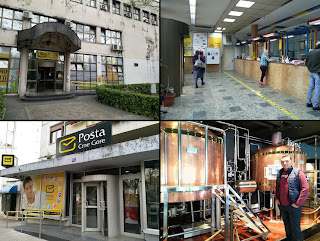 |
| פודגוריצה: סניפי דואר, מבשלת בירה צילום: אמיר אפסאי Podgorica main post office (top) Bulevar Svetog Petra Cetinjskog post office Akademija Piva: Zdravko Miks Photos: Amir Afsai |
On my way to Poddy's only craft beer venue, Akademija Piva, I walked past a neighborhood post office on Bulevar Svetog Petra Cetinjskog but only lingered long enough to snap a photo of its unusual exterior. At Akademija Piva I was introduced to brewmaster Zdravko Miks, who led me on an impromptu guided tour of the brewing facility and lamented at length the unrefined Montenegrin palate, which demands no higher standard than that set by the region's mass-produced beers. A waiter then poured me samples of three beers: an IPA, a Weissbier and a Christmas lager. Craft breweries like Akademija Piva have a delicate balancing act to perform between being unique and being popular, being craft and being a brewery. If it were up to Zdravko Miks, he would be producing beers that are innovative, cutting-edge and radical; but a brewery is a business and as such needs to appeal to a consumer base large enough to ensure consistent profitability. In the case of Akademija Piva, it is the second of these considerations that is their business model's primary focus. Their products, while enjoyable, were ordinary. There was no Stout, no Porter, no Chili, no Sour, no Imperial, no Tripel, no Barrel-aged, and nothing experimental or that could be construed as uniquely Montenegrin.
Day 5, Tuesday:
- Orahovačka St. post office / Philatelic Bureau
 |
| סניף דואר רחוב אורהובצקה צילום: אמיר אפסאי Orahovačka Street post office Photo: Amir Afsai |
No big deal, I thought. I walked back to my property, returned to the guard in pants, and climbed the stairs to the first floor. Except that what awaited me there did not in the least resemble a philatelic bureau: it was a large hall full of P.O. boxes. The two clerks on duty confirmed there was no filatelija there and insisted I would find it down at the post office. The security guard downstairs listened sympathetically as I shared my exasperation. His eyes narrowed, his jaw clenched, and his posture straightened. His body language signaled more than he could articulate in words: Rest assured, my friend, I am taking charge of the situation and will find you your philatelic bureau. His solution? To stare intently at his CCTV monitors and watch for clues. This is hopeless, I thought, and was about to exit the building, but the guard implored my patience. A few minutes passed and, confident he had solved the case, the guard instructed me to go to the rear of the building, assuring me that was where I would find the philatelic bureau. Skeptical, but out of options, I walked back around the building and opened the door that looked to hold the most promise. Of course it was not the philatelic department; it was a vast sorting room. Heads turned to look at me, I looked at them, and a long moment passed with no one sure what to do next and parcels tumbling off a conveyor belt onto the floor. Finally I broke the silence: "Filatelija?" A woman's arm slowly moved from side to side, a finger at its end pointing to my left.
Retreating back outside, I turned and knocked on the door to my left half expecting to find on the other side a utility closet or a toilet. There was no answer, and I slowly turned the handle and pushed the door open. A cloud of cigarette smoke assaulted me like it had been trapped inside and I was liberating it from years of captivity. Through the haze an office came into focus: a table with bundles of first day covers on it surrounded by metal racks with binders on the shelves. "Hallo?" I called. A woman appeared and, closing the door behind me, led me down a corridor to a second office, where another woman was sitting at a computer. The sofa they invited me to sit in was so plush I was sure I'd need a hand to pull me out of it. On the wall across from the sofa hung a framed picture of Pošta Crne Gore's 2005 EUROPA viticulture stamp. Perfect. I'll be able to add a sheet and first day cover to my enophilately collection. There was also a framed picture of a stamp depicting what looked like a stylized letter from the Cyrillic alphabet, alphabets being another of my topical interests. What there wasn't was small talk with either of the ladies, since neither could speak English. Pointing at the pictures on the wall, I asked to start with those stamps. They shook their heads to indicate that neither was available for sale. Instead, they sat me at a computer, brought up the Pošta Crne Gore website, and directed me to explore the online catalog and select what I wanted from there going back ten years. I felt like a kid forced to take a test he hadn't studied for. Amid dozens of unfamiliar faces and meaningless landmarks, only one stamp registered as familiar: a 2012 €0.95 "Posjetite Crnu Goru" stamp featuring a view of Sveti Stefan and issued for EUROPA's Visit... theme of that year. I bought a 3×3 minisheet -- eight stamps surrounding a central label, № 5907 -- for €7.60, which they packaged neatly in a display card and an envelope. Could I buy the corresponding first day cover? No. Could I get any first day covers? No. Could I take a picture of the wall? No. Could I take any pictures? No.
Day 6, Wedensday:
- Orahovačka St. post office
- 27 Marta St. post office
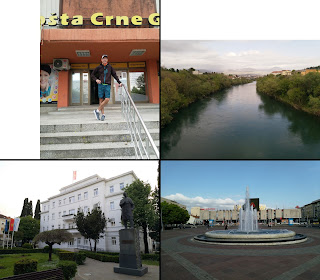 |
| סניף דואר רחוב אורהובצקה (שמאלי עליון) נהר מורצ'ה, העירייה, כיכר העצמאות Orahovačka Street post office (top left) Morača River, Municipal Assembly, Independence Square |
Other than a couple of momentary sprinkles, the rain held off. Two kilometers into the run I came upon a small post office and stopped with the intention of snapping a photo, but two ladies were having a conversation outside the door and I forwent the invasion of privacy taking a picture at that moment would have entailed. On the next block over, three girls were crouched behind a crate selling toy figures, and I more strongly regret not having captured that scene on camera. Beyond the kids a park with a basketball court beckoned to me, but closer inspection revealed it was being used for a pickup game of soccer. Then came the Morača River, the tallest building I came across in Poddy, the University of Montenegro, and an area of coffee shops and bars that looked like it might be worth revisiting in five or ten years. With a little more creativity and foreplanning, there was probably more I could have squeezed out of the run; but the fact I got out at all, made it back dry, and even found a park to do pull-ups in at the end was enough to be grateful for.
Day 7, Thursday:
- Cetinje main post office
- King Nikola Museum
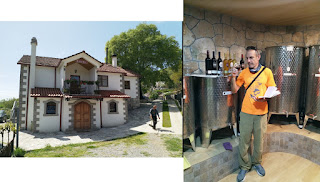 |
| יקב מרקאן Mrkan Winery |
- Dukat suvo (2018) -- dry white, blend of Serbian Župljanka and Georgian Rkatsiteli; mild vegetal aroma, citrus, some alcohol notes; taste is lemon juice. 4/5. Bottle sells for €8.
- Dukat poluslatko (2017) -- semisweet white, 1 year in wood (?); herbal aroma, thyme, rosemary; similar herbal notes on taste, gin-like; unique in a good way but maybe too unusual. 4/5. Bottle sells for €10.
- Vrhunsko (2018) -- red; aroma of grilled steak, steamed brown portobellos, spice; taste is fruity, fresh strawberries and blueberries, apricot puree. 4/5. Bottle sells for €8.
- Barrique (?) -- red, 1 year in wood; aroma of deep wood, wine-soaked cork; taste dominated by leather, rich, flawlessly harmonized; mouthfeel is velvet, body is full, finish is long. 5/5 -- masterpiece, best new wine I tasted in years. Bottle sells for €10.
- Vrhunsko poluslatko (2017) -- semisweet red; pungent aroma of jam, fermented fruit, syrup; taste is exceedingly sugary, bubblegum; long finish. 3/5. Bottle sells for €15.
The tour and tasting, of which I understood roughly two words -- "tradition" and "natural" -- concluded with a shot of delicious brandy after which, cradling a bottle of Barrique, I returned to the car and got back on the road. From Mrkan it was a 30-minute drive to Marković Vineyards and what I consider the climax of my Montenegro trip. Greeting me at Marković was a clairvoyant construction worker whose first words upon laying eyes on me were, "You are from Israel?" That being more or less the extent of his English vocabulary, he put me on the phone with a gentleman who introduced himself as the construction worker's son and announced he was on his way to meet me at the winery.
 |
| כרמי מרקוביץ Marković Vineyards |
- Thumiama (2019) -- white, made from White Tamjanika grape; explosive aroma of white grapefruit, banana, citrus blossoms in bloom, perfume, lemon, Belgian yeast; sour on the palate, hard pear, green apple; dynamic finish. 5/5 -- masterpiece, best white wine outside of France. Bottle sells for €14.
- Inat (2019) -- red, made from Black Tamjanika grape, 75% aged for three months in French (or Serbian sessile?) oak; aroma of fruit punch, pomegranate, berry-soaked cloth; similar fruity taste but more restrained, sharing the stage with tannins; velvet texture, moderate to long finish. 5/5 -- masterpiece. Bottle sells for €19.
- Zublja -- "Torch"; red, 100% Vranac.
- Eskaton -- 100% Sauvignon blanc.
The reason there are no tasting notes for the last two wines is I was approaching a point where standing, drinking, conversing, and writing were too many tasks for my increasingly inebriated CPU to manage all at once. Writing had to go. I also had to refuse a pour of Amò rosé so as to forestall the need for a nap in the car prior to getting back on the road. Nikola insisted on gifting me a bottle of Thumiama for being his first guest at the winery, and I insisted on buying a bottle of Inat because its aftertaste was haunting my gustatory cortex. I thus drove off with three bottles of wine riding shotgun and as many days left to consume them.
 |
| מוזיאון הכסף (שמאלי עליון) סניף דואר צטיניה, מוזיאון המלך ניקולא צילום: אמיר אפסאי Museum of Money (top left) Cetinje post office, King Nikola Museum Photos: Amir Afsai |
Appreciating the history of Montenegro and the identity of its people is impossible without understanding the legacy of King Nikola I (1841-1921) -- and what better place to undertake that journey than at Cetinje's King Nikola Museum? Although not as impressive from the outside as the post office, the museum's interior, consisting mainly of furniture, portraits and personal items belonging to the royal family, was captivating. One of the exhibits in the museum was a stamp collection, about which the brochure had this to say:
Here are displayed series of Montenegrin stamps, dating from 1874 when the Postal Convention between Montenegro and Austria-Hungary was concluded and a postal station in Cetinje was opened until the proclamation of the Kingdom of Montenegro in 1910, with portraits of the royal couple, printed by concept drawings of the Montenegrin artist Ilija Sobajic.Pošta Crne Gore issued a "100 g. obnavljanja crnogorskog kraljevstva" stamp celebrating the centennial of the Montenegrin kingdom's restoration in 2010, an "Ilija Šobajić" stamp in 2012, and a "Zamkovi — Dvorac kralja Nikole na Cetinju" ("Castles — Palace of king Nikola at Cetinje") stamp in 2017.
Aside from updates relating to the SARS-CoV-2 pandemic and a political controversy surrounding the Srebrenica massacre of 1995, the major story making headlines in Montenegro during my visit involved a $1 billion loan that Montenegro took from China in 2014 and appeared dangerously close to defaulting on. In similar fashion to how Chinese companies have been able to gain control of strategic European assets in Spain, Greece and elsewhere, construction of a 165-kilometer (103-mile) highway in eastern Montenegro was opening the door for China to establish a key outpost in the Balkans. Driving from Cetinje to Kotor on roads whose condition was vastly superior to, say, Armenia's or even the United States', Montenegro's desperation for such an extravagant project was baffling. Upon arrival in Kotor, I uncorked the bottle of Inat and savored most of it at the port in the company of some teenage fishermen and cats while the sun set.
Day 8, Friday:
Day 9, Saturday:
- Kotor post office
- Kotor Old Town post office
- Cats of Kotor
 |
| קוטור: סניפי דואר, חתולי קוטור צילום: אמיר אפסאי Kotor post office (top), Old Town post office, Cats of Kotor Photos: Amir Afsai |
Although the old town's post office was closed, my walk to it was not without its rewards. Yellow had to be the dominant color of the building exterior, since that is the brand color of Pošta Crne Gore, but care was taken to integrate the facade into the old town's ambience. Yellow awnings over the entrance and a display window with a yellow mailbox in between served both to distinguish the post office from surrounding businesses and to lend it an esthetic charm. Moreover, outside the entrance was a large metal chest, also yellow, that looked like a cross between a mailbox, a strongbox and a jukebox. My stroll around the old town concluded with a stop at Cats of Kotor, a cat-themed novelty shop with a cat-themed stationery stand that had cat-themed postcards.
Day 10, Sunday:
- Perast post office
- Church of Our Lady of the Rocks museum
- Prčanj post office
- Donji Stoliv post office
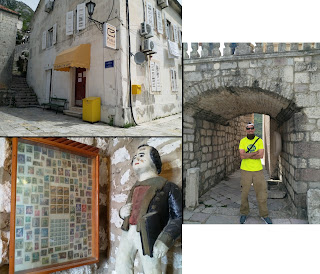 |
| פראסט (שמאלי עליון); גבירתנו של הסלעים Perast post office (top left) and Our Lady of the Rocks |
Half expecting Our Lady of the Rocks to be a tourist trap at this point, I was on the verge of returning to the car when a last-minute change of heart led me to one of the docks and to a boat bound for the island. The story goes, my driver explained, that two brothers were fishing off the coast of Perast and they had a vision of the Virgin Mary. Thereafter, they made it a custom to return to the site of the vision and throw stones into the water there. After four hundred years, they discovered their stones had formed an island, which grew and grew as their custom became tradition among local fishermen. An altar was made, and that developed into the church that exists today. Far from being a tourist trap, the island church was unique for a series of maritime-themed silver panels mounted to the walls by pilgrims. The stairway leading up to a museum on the church's second floor had a framed stamp collection hanging from the wall.
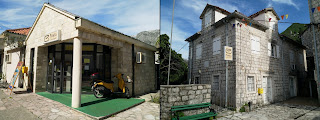 |
| סניפי דואר של פרצ'נג' (משמאל), דונג'י סטוליב צילום: אמיר אפסאי Post offices of Prčanj (left) and Donji Stoliv Photos: Amir Afsai |
Back in Kotor, I opted to go for the run rather than climb the mountain. An ankle or Achilles injury sustained in 2020 was still hampering me, and a run on a flat coastal road seemed the lesser of two evils when weighed against a hike up a mountain -- especially considering I was without travel insurance. The run was a scenic out-and-back, passing by exquisitely preserved classic architecture and two memorable post offices and with an extended rest taken at the turnaround point to schmooze with a friendly couple visiting from Serbia -- the male half of which had visited Israel and, as I would later learn via correspondence, also dabbles in philately. Around 14 kays (9 miles) into the run, ankle pain threatened to limit me to walking the rest of the way, but hunger propelled me on. Shortly after returning to Kotor, I was relieved to discover that the result of a SARS-CoV-2 PCR test taken in the morning came back negative, and that was the signal to start packing for the flight back.
Day 11, Monday:
 |
| נמל תעופה טיווט צילום: אמיר אפסאי Tivat Airport Photos: Amir Afsai |
Conclusion:
What are the odds that I visited a total of three museums in Montenegro and at all three found a connection to philately or deltiology? Either it was happenstance or it reflects a deeper cultural appreciation for stamps and postcards than exists in other countries.
It stands to reason there are countries in the world besides Montenegro where getting a piece of mail hand-canceled is still completely natural. Israel, regrettably, is not one of them. Here, one practically has to bribe the postal clerk for such a service.

You write very well
ReplyDeleteAmir, you wrote a nice travelogue.👌🎩🍀✅
ReplyDeleteYou have few person near Your city in Israel, who know well "Te Montenegro" and mentality people live there! At my time, there was an joke, that even on central radio station, in Montenegro, they say: "Good morning people of Montenegro! It is exactly twelve a clock" ... I remember, how it was hard to work with Post office in Montenegro, from start of day one of Independence, bureaucracy, way of doing business, paperwork, custom paperwork attached on shipment from Montenegro, and in the end, shipment of half kilogram! Custom officer in Israel was thinking that I have "smuggling ring" with Philately! Any way, it is nice country, worth to visit, and very good (and proud) people!
ReplyDelete